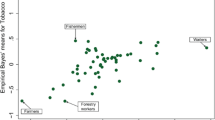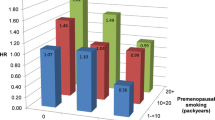A history of previous primary cancer and of radiotherapy were investigated as risk factors for lung cancer in lifetime nonsmokers in a hospital-based case-control study. By design, subjects with a previous tobacco-related primary (of the lung, larynx, oropharynx, esophagus, kidney, bladder, or pancreas) were excluded. Information was available on 30 male and 47 female lung cancer cases and 87 male and 132 female controls, all lifetime nonsmokers, interviewed in hospitals in four United States cities between 1985 and 1990. In males, neither a history of a previous primary nor a history of radiotherapy was associated significantly with lung cancer; however, the numbers of exposed cases were small. In females, after adjustment for age, education, hospital, lifetime environmental tobacco-smoke exposure, and body mass index, both a history of a reproductive primary and a history of radiotherapy were associated significantly with lung cancer (odds ratio [OR]=4.9,95 percent confidence interval [CI]=1.4–17.7, and OR=4.4, CI=1.3–15.1, respectively). Due to a high correlation between a history of a reproductive primary and a history of radiotherapy in the cases, it was not possible to estimate the effect of one exposure independent of the other. These results are consistent with the possibility that endocrine factors may play a role in some lung cancers in women.
Similar content being viewed by others
References
Koo LC, Ho JHC. World wide epidemiological patterns of lung cancer. Int J Epidemiol 1990; 19: S14-S23.
Kabat GC, Wynder EL. Lung cancer in non-smokers. Cancer 1984; 53: 1214–21.
Kuller LH, Garfinkel L, Correa P, et al. Contribution of passive smoking to respiratory cancer. Environ Health Perspect 1986; 70: 57–69.
Fraumeni JFJr., Blot WJ. Lung and Pleura. In: Schottenfeld D, Fraumeni JFJr., eds, Cancer Epidemiology and Prevention. Philadelphia, PA: W. B. Saunders & Co., 1982.
Kabat GC. Recent developments in the epidemiology of lung cancer. Semin Surg Oncol 1993; 9: 73–9.
Kabat GC, Hebert JK. Use of mentholated cigarettes and lung cancer risk. Cancer Res 1991; 51: 6510–3.
Kabat GC, Wynder EL. Body mass index and lung cancer risk. Am J Epidemiol 1992; 135: 769–74.
SAS Institute, Inc. SAS/STAT User's Guide. Version 6, 4th Ed. Cary, NC: SAS Institute, Inc., 1990.
National Research Council. Environmental Tobacco Smoke: Measuring Exposures and Assessing Health Effects.. Washington, DC: National Academy Press, 1986.
Faccini JM. The role of histopathology in the evaluation of risk of lung cancer from environmental tobacco smoke. Exp Pathol 1989; 37: 177–80.
Fontham ETH, Correa P, Wu-Williams A, et al. Lung cancer in non-smoking women: a multicenter case-control study. Cancer Epidemiol Biomarkers Prev 1991; 1: 35–43.
Kohn HI, Fry RJM. Radiation carcinogenesis. N Engl J Med 1984; 310: 504–11.
National Research Council, Committee on the Biological Effects of Ionizing Radiation. The Effects on Populations of Exposure to Low Levels of Ionizing Radiation. Washington, D.C.: National Academy of Sciences, 1980.
Court Brown WM, Doll R. Mortality from cancer and other causes after radiotherapy for ankylosing spondylitis. BMJ 1965; 2: 1327–32.
Neugut AI, Robinson E, Lee WC, et al. Lung cancer after radiation therapy for breast cancer. Cancer 1993; 71: 3054–57.
McDuffie HH, Klaassen DJ, Dosman JA. Determinants of cell type in patients with cancer of the lungs. Chest 1990; 98: 1187–93.
Chaudhuri PK, Thomas PN, Walker MJ, et al. Sterold receptors in human lung cancer cytosols. Cancer Lett 1982; 16: 327–32.
Kobayashi S, Mizuno T, Tobioka N, et al. Sex steroid receptors in diverse human tumors. GANN 1982; 23: 439–45.
Beattie CW, Hansen NW, Thomas PA. Sex steroid receptors in human lung cancer. Cancer Res 1985; 45: 4206–14.
Cagle PT, Mody DR, Schwartz MR. Estrogen and progesterone receptors in bronchogenic carcinoma. Cancer Res 1990; 50: 6632–5.
Annegers JF, Malkasian GD. Patterns of other neoplasia in patients with endometrial carcinoma. Cancer 1981; 48: 856–9.
Harvey EB, Brinton LA. Second cancer following cancers of the breast in Connecticut, 1935–82. NCI Monogr 1985; 68: 99–112.
Curtis RE, Hoover RN, Kleinerman RA, Harvey EB. Second cancer following cancer of the female genital system in Connecticut, 1935–82. NCI Monogr 1985; 68: 113–37.
Ewertz M, Mouridsen HT. Second cancer following cancers of the female breast in Denmark, 1943–80. NCI Monogr 1985; 68: 325–9.
Gao Y-T, Blot WJ, Zheng W, et al. Lung cancer among Chinese women. Int J Cancer 1987; 40: 604–9.
Adami H-O, Persson I, Hoover R, Schairer C, Bergkvist I. Risk of cancer in women receiving hormone replacement therapy. Int J Cancer 1989; 44: 833–9.
Sellers TA, Potter JD, Folsom AR. Association of incident lung cancer with family history of female reproductive cancers: the Iowa Women's Health Study. Genet Epidemiol 1991; 8: 199–208.
Michnovicz JJ, Hershcopf RJ, Naganuma H, et al. Increased 2-hydroxylation of estradiol as a possible mechanism for the anti-estrogenic effect of cigarette smoking. N Engl J Med 1986; 315: 1305–9.
Additional information
Dr Kabat is with Albert Einstein College of Medicine, Bronx, NY, USA. At the time of this work, the author was in the Division of Epidemiology, American Health Foundation, New York, NY, USA. Address correspondence to Dr Kabat, Department of Epidemiology and Social Medicine, Albert Einstein College of Medicine, Belfer Building, Rm 1302, 1300 Morris Park Avenue, Bronx, NY 10461-1602, USA. This work was supported by US National Cancer Institute Program Project grant CA32617 and Center grant CA17613.
Rights and permissions
About this article
Cite this article
Kabat, G.C. Previous cancer and radiotherapy as risk factors for lung cancer in lifetime nonsmokers. Cancer Causes Control 4, 489–495 (1993). https://doi.org/10.1007/BF00050869
Received:
Accepted:
Issue Date:
DOI: https://doi.org/10.1007/BF00050869




